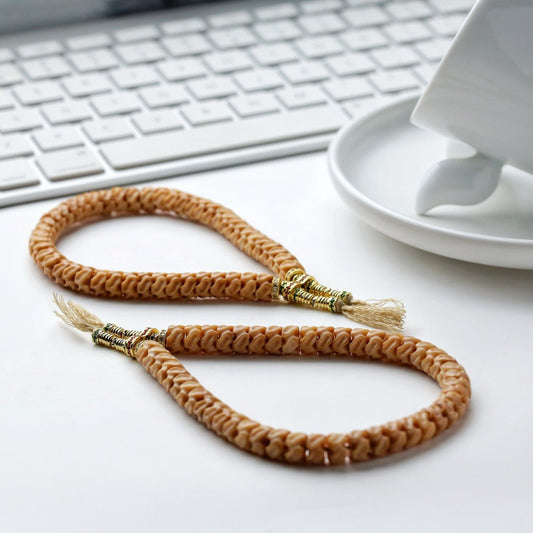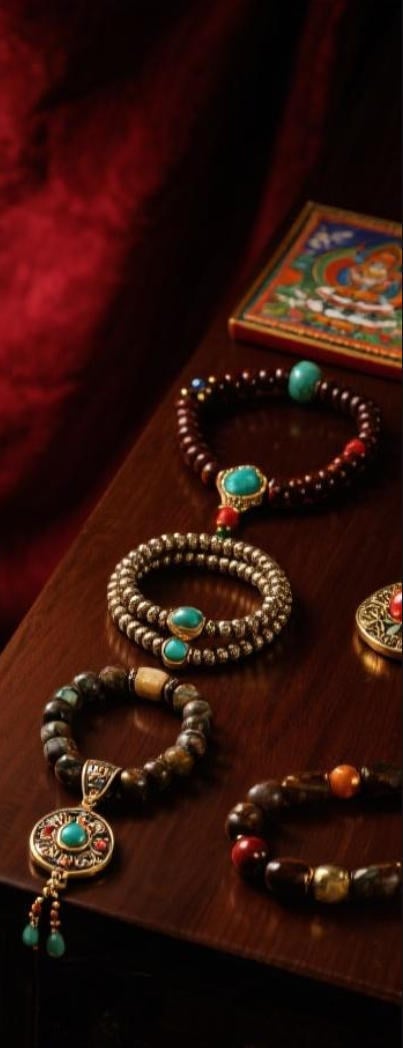exceptionally crafted Buddhist jewelry embodying enlightenment?

Inside the elaborate weave among Tibetan sacred practices lie two compelling artifacts: the traditional thangka and bodhi prayer bead. Every single one, in individualized approach, enables transcendental awakening. The thangka, a hand-painted tableau, delineates sacred characters, spiritual mandalas, or traditional chronicles, assisting meditative practice.
By comparison, the bodhi bead, often crafted from precious gemstones, timber, berries, or calcium deposits, is a tangible reminder of Buddha's enlightenment under the bodhi tree. Holding these beads during prayer or meditation helps to focus the mind.
- As a pair, the thangka and the bodhi bead demonstrate the path to liberation. They offer a tangible link to the primeval enlightenment of Tibetan Buddhism.
Legends Echoed from Camel Remains
Spanning bygone centuries, primordial treasures whisper tales about a world long lost. These are not precious objects of lost empires, but elementary camel bones etched with symbols that enclose the mysteries of a bygone time. Each segment embodies the echo derived from a life lived, a journey completed, and a connection to the timeless wisdom embracing which enfolds us all.
- It
- Gifts
- Are
Interpreting the Visual Narratives of Thangka
Tangkas are glowing paintings on canvas, meticulously crafted by Tibetan artists to depict hallowed figures and scenes from Buddhist teachings. Each detail within a thangka is laden with depth, forming a complex tapestry of visual narratives that guide the viewer on a spiritual journey. The tones used in thangkas are not merely aesthetic choices but carry powerful connotations, reflecting different aspects of the Buddhist practice. From the solemn figures to the intricate motifs, thangkas offer a outlook into the rich world of Tibetan Buddhism, inviting us to ponder upon its principles.
- Traditional thangka art often depicts key Buddhist figures such as Buddha Shakyamuni, Bodhisattvas like Avalokiteshvara and Manjushri, and enlightened beings from various schools of Tibetan Buddhism.
- Within these representations lies a wealth of learnedness that can be revealed by those who engage the symbolic language of thangkas.
Siddhartha's Path to Enlightenment: Embodied in Beads and Bone
Upon the winding course to awakening, the Buddha embraced emblems imbued with profound depth. Separate bead and relic held within them the fundamentals of his wisdom, disclosing glimpses into the structure of reality. Using their contour, the Buddha conveyed profound verities that exceed the realm of physical perception.
From these contemplative beads, crafted from exotic materials, emerged vibrations that echoed with the delicate currents within. The bone of a individual, meticulously transformed into emblems, served as tangible markers of the impermanence basic to all beings.
Thangkas: Windows into Himalayan Spirituality
Thangkas radiant paintings on cloth serve as effective representations of Himalayan spirituality. These intricate works of art, meticulously created with exquisite brushstrokes, depict a vast array consisting of Buddhist deities, mandalas, and scenes from esteemed scriptures. Each thangka is an instructive medium for meditation and contemplation, offering discernment into the profound teachings of Buddhism.
- They are often used in ritual ceremonies in the context of
- inspiring states of spiritual illumination.
- Thangkas appear as not merely decorative works but rather entries into the rich and captivating world of Himalayan spiritual traditions.
Bodhi Beads: Embracing Mindfulness and Cultivating Compassion
Each pearl on a bodhi bead mala whispers tales of ancient wisdom, guiding us on a passage through the tranquil waters of mindfulness. As we grip these intricately made beads, our fingers trace the contours of every one, anchoring our awareness in the present moment. The gentle substance of the beads against our palms serves as a tangible reminder to draw breath, fostering a sense of quiet.
- At every bead that passes between our fingers, we foster compassion, extending it first to ourselves and then outward to the world.
- Sacred teachings teaches us that mindfulness is a skill that requires patience and commitment.
Via the rhythmic repetition of mantra or simply the mindful registering of the beads, we break free from the relentless chatter of the mind.
The practice utilizing bodhi beads is a graceful invitation to revive our connection with ourselves and the world around us.
Spiritual Artistry: Designing Camel Bone Bracelets for Growth
Intention is a powerful force in our lives, shaping our experiences and guiding us towards our ultimate purpose. When we combine this intention with the traditional practices of crafting a camel bone bracelet, we create a potent synergy that can catalyze our spiritual growth.Camel bone carries profound symbolism, representing fortitude. Its natural beauty and unassuming elegance serve as a constant reminder of the vibrant energy within each of us.Once bones are chosen with care, flow affirmations into the bracelet. With every knot or join, we embody our hopes, dreams, and aspirations for spiritual evolution. This act of creation becomes a meditative practice, merging us with our inner wisdom and guiding us on a voyage of awakening.- Draw inspiration from the bone’s inherent patterns.
- Envision the bracelet becoming a conduit for your intentions.
- Bless the bracelet in ceremonies to infuse vitality.
The Enduring Impact of Camel Bone in Buddhism
In the rich tapestry of Buddhist tradition, artifacts often hold profound symbolic meaning. Across these varied objects, camel bone stands out as a peculiar and captivating element. Throughout history, this material has been employed in the crafting within various Buddhist relics, each imbued with specific denotations.
- Acknowledged as a symbol of resilience and strength due to the camel's ability to overcome in harsh environments, camel bone often represents spiritual fortitude.
- Furthermore, the color and texture for camel bone are believed by some to hold auspicious connotations, symbolize purity and serenity.
Therefore, camel bone has become a significant part of Buddhist tradition, serving as a tangible connection to the profound teachings of this ancient faith.
Thangka Masterpieces: Narratives in Color
Within the ethereal realm of Tibetan Buddhism, Thangka paintings emerge as sacred portals to enlightenment. These remarkable works, meticulously crafted by skilled artists known as thangkapa, depict a myriad with a spectrum of vibrant deities, celestial beings, and mythical creatures. Each brushstroke imbues profound spiritual significance, narrating ancient tales and philosophical theories.
- Offering a vast anthology of Buddhist iconography, Thangkas serve as both devotional objects and instructional tools. Faithful practitioners gaze upon these paintings during rituals and meditations, seeking to pursue spiritual wisdom.
- Elegantly fashioned with intricate details embellished by diverse vibrant hues, Thangkas are considered windows into the divine. Any painting acts as a symbolic representation of the Bodhisattva's teachings and the path to liberation.
By the use of their dominant imagery and symbolism, Thangka paintings offer a glimpse into the rich spiritual traditions of Tibet. They are a testament to the enduring excellence of Tibetan art and its profound ability to illuminate.
Embracing the Duality: Thangkas and the Cycle of Life and Death
Thangkas, these vibrant woven scrolls from Tibet, offer a profound reflection on the transient nature of existence. Each intricate rendering depicts deities and beings engaged in the developing path of life and death, a concert of birth, growth, impermanence, and renaissance. The artists skillfully intertwine these concepts within the thangka's sphere, highlighting the cohesion of all things. Through vivid motifs, they invite us to consider on our own experience. The cycle continues, a pattern of coming and going, accentuating the preciousness of each moment. By embracing this duality, thangkas teach us to value the beauty in both life's joys and sorrows.String of Mindfulness: The Significance of Bracelets in Buddhist Practice
In the intricate tapestry of Buddhist practice, seemingly modest objects often hold profound meaning. Among these are bracelets, which serve as tangible badges of devotion and commitment to the teaching of Buddha. Worn on the wrist, a bracelet operates as a constant reminder of one's aspirations and ambitions. It can indicate the impermanence of life, urging practitioners to remain present in the present moment. Some bracelets may contain sacred inscriptions, such as mantras or the names of Buddhas, which are regarded to channel positive energy and security. Tibetan-style prayer beads Others are often made from components with spiritual significance, like sandalwood or lotus seeds, amplifying the bracelet's influence. Ultimately, the significance of a Buddhist bracelet lies far beyond its physical form. It becomes a powerful tool for introspection, a encouragement to live in harmony with the teachings of Buddha, and a channel of one's unwavering confidence.